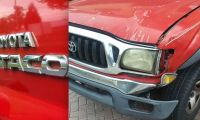Tap Water Makes a Poor Coolant/Antifreeze for Cars
At one time or another you’ve probably done this: topped off your radiator with water every time your radiator was low on coolant/antifreeze. While doing this in an emergency is ok---I mean it’s an emergency, right? ---relying on water to be good enough for your engine as a coolant is a common mistake many car owners make. Especially those living in warmer regions where below freezing temperatures almost never happens and they believe antifreeze is not really necessary.
There are a few good reasons why this is a bad practice.
One, you are diluting your engine’s required 50:50 antifreeze/coolant to water ratio with increasingly less on the coolant/antifreeze ratio side, each time you decide to top off your radiator with water.
That 50:50 mix is important because it is the optimal mix to ensure that your engine’s coolant/antifreeze solution will perform over a wide range of temperatures typically between minus 30 degrees Fahrenheit to 275 degrees Fahrenheit. Remember, water freezes at 32 degrees and boils at 212 degrees.
Dilute the original coolant enough times and you are essentially causing your engine to run hotter resulting in increased wear. And, if you forget to replace that diluted coolant before winter hits, you also run the risk of a split engine block when the diluted coolant/antifreeze freezes into ice.
Another reason why diluting your coolant/antifreeze is a bad idea is that additives in the commercial coolant/antifreeze actually help prevent corrosion from occurring inside the block and the narrow passages within your radiator. Tap water is full of minerals, leads to acidic conditions in the block, and hastens corrosion.
Check This Whenever Buying a Used Car
Coolant/Antifreeze solutions come in a variety of easy-to-see colors such as green, yellow, pink, orange, or red. One red flag check when considering buying a used car is to open the radiator cap to see whether the coolant has color indicating proper maintenance in that respect. But if it is nearly clear to colorless, it could indicate an owner who poorly maintained his or her vehicle that could have problems in the near future.
An Informative Video on When Water is Used as a Coolant
The origin of this topic is due to a recent Wrenching With Kenny YouTube channel video where Kenny shows a used truck engine he was hired to replace in a truck with a blown engine. The used engine bought cheap at a junkyard reportedly had only about 50,000 miles on it.
While disassembling the new-used engine Kenny discovered that the block had (1) cracks due to freezing temperatures caused by water used as coolant. And (2), an attempt to treat that cracked block with a “stop leak” product that shows exactly why you should never resort to these kind of mechanic-in-a-can products.
Related article: What Happens When Your Car’s Oil Filter Gets Clogged (especially with a stop leak product)
That said and done, here is a short informative video that supports this article’s warning about your engine’s coolant/antifreeze care.
Complete Engine Destruction in 3, 2, 1... It's Called Antifreeze for A Reason...
And finally…
For additional articles related to car maintenance, here are a few for your consideration:
• Don't Waste Your Money on This Automotive Snake Oil Scam
• Exhaust Smoke Diagnosis Explained in Detail
• Rattle Can Repair Scam Warning for Used Car Shoppers
Timothy Boyer is a Torque News automotive reporter based in Cincinnati. Experienced with early car restorations, he regularly restores older vehicles with engine modifications for improved performance. Follow Tim on Twitter at @TimBoyerWrites for daily new and used vehicle news.
Image Source: Pixabay












